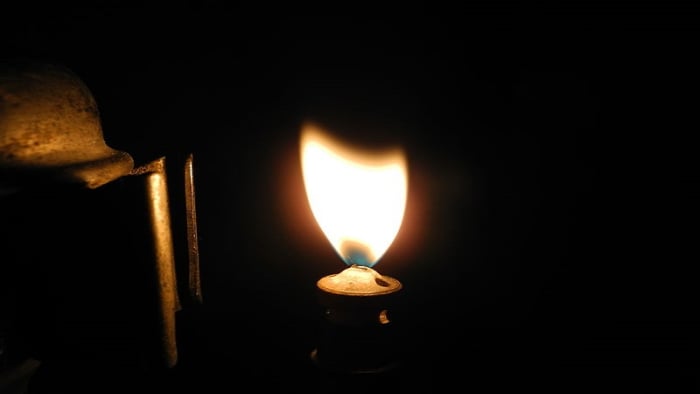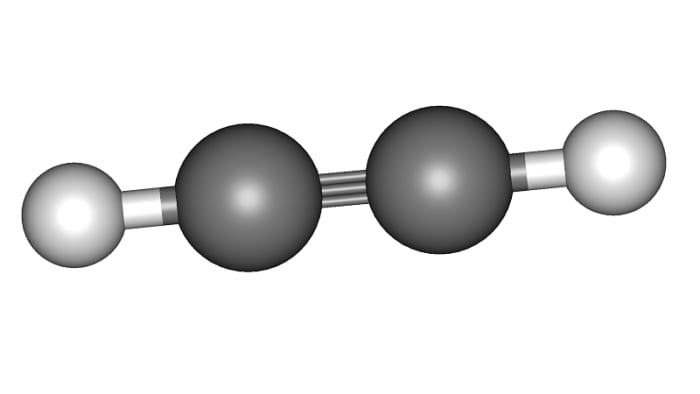Characteristics of alkynes and hydrogenation of acetylene
Features of hydrogenation of alkynes

Alkynes (or acetylene hydrocarbons) are unsaturated hydrocarbons, with the common formula of CnH₂ₙ₋₂ (n is the number of carbon atoms). Compounds of this type have a triple covalent bond in their structure. The two carbon atoms are in a trouble bond, each of which is in the state of sp-hybridization (this is a special type of overlap of atomic orbitals, when one s and one p-orbital are mixed, and the other two are located perpendicularly and form a p-bond or hold a lone electron pair) – this is why the geometry of this compound of atoms is linear. For example, the simplest alkyne – acetylene C₂H₂ is located on a plane lineally: the angle between carbon atoms in the compound is 180 degrees.
Physical properties
The first three alkynes in their homologous row (in this row substances differ by length – each new hydrocarbon resembles the previous one by its structure, but differs by one structural unit of CH₂) are gases:
-
HC≡CH (C₂H₂ - ethyne, or acetylene);
-
HC≡C-CH₃ (C₃H₄ - propyne);
-
HC≡C-CH₂-CH₃ (C₄H₆ - butyne).
The principle of addition in the homologous row of homologous difference of CH₂ is clear:

С₂Н₂ + СН₂ = С₃Н₄;
С₃Н₄ + СН₂ = С₄Н₆ (with the addition of CH₂ to the previous alkyne, the next one is obtained).
All alkynes, starting with petyne and ending with alkyne with 16 carbon atoms, exist in normal conditions in the form of liquids. The higher alkynes, starting with C₁₇H₃₂, take the form of solids. All compounds with a triple bond dissolve poorly in water, and well in nonpolar solvents (organic – for example benzol).

Isomerism of alkynes
Isomerism is the phenomenon of compounds which are identical in composition but different in structure. For alkynes, there are three types of isomerism:
-
interclass (alkynes isomerized by alkadienes, hydrocarbons with two double bonds – for example propyne and propadiene – interclass isomers with the formula C₂H₄ (propyne has one triple bond between carbon atoms and one ordinary, while propadiene has two double bonds);
-
isomerism of the position of the triple bond (in butyne the triple bond may be located at the first and second carbon atom – accordingly, butyne-1 and butyne-2 differ respectively: CH≡C-CH₂-CH₃ и CH₃-C≡C-CH₃);
-
isomerism of chain (the structure of the chain in alkynes may differ – for example hexyne-2 CH₃-CH≡C-CH₂-CH₂-CH₃ is isomerized by 4-methyl pentyne-2 CH₃-CH≡C-CH₂(CH₃)-CH₃).
Spatial (geometric) isomerism, in which a compound has identical structure and composition but different location of atoms in space, is not characteristics for alkynes.
Obtaining alkynes
The common method for obtaining all homologs of acetylene is the reaction of dihaloalkanes with an alcohol solution of an alkali (elimination reaction). Halogens may be located on adjacent atoms of carbon, and on the same one (summary equations are given):
-
CH₃-CH₂-CHBr₂ + 2NaOH = CH₃-C≡CH + 2NaBr + 2H₂O;
-
CH₃-CHCl-CHCl-CH₃ + 2KOH = CH₃-C≡C-CH₃ + 2KCl + 2H₂O.
Main industrial method of obtaining acetylene CH≡CH (C₂H₂):
6CH₄ + O₂ = 2C₂H₂ + 2CO + 10H₂ (reaction is carried out at a temperature of around 1500 ᵒC or 2732 ᵒF).

A similar product of reaction can be obtained by the thermic breakdown of methane:
2CH₄ = C₂H₂ + 3H₂ (temperature of breakdown – around 1200 ᵒC or 2192 ᵒF).
The simplest alkyne (acetylene) can be obtained from calcium carbide:
CaC₂ + 2H₂O = C₂H₂ + Ca(OH)₂.

In the presence of a strong alkali, acetylene can be obtained from di-haloalkane in 2 stages:
-
CH₂Cl-CH₂Cl + KOH(alcohol) = CH₂=CH-Cl + KCl + H₂O;
-
CH₂=CH-Cl + KNH₂ = C₂H₂ + KCl + NH₃.
Chemical properties of alkynes
By their reactive ability, alkynes are in many ways similar to alkenes, but there are also other special reactions for them that are only characteristics for compounds with a triple bond of reaction.
Alkynes enter into reactions of substitution, attachment, oxidation and polymerization. The most important and widespread reactions of alkynes are given below.
-
Reactions of oxidation of alkynes
-
Oxidation of alkynes can be complete and incomplete. In the first case, the combustion of unsaturated carbon with a triple bond takes place:
2CH≡CH + 5O₂ = 4CO₂ + 2H₂O (sooty flame).

- Incomplete combustion is carried out in the presence of potassium permanganate in a neutral medium, or of potassium dichromate in an acidic medium (for simplicity, atomic oxygen [O] is given in the reaction, as this particular is released in the contact of permanganates or dichromates with organic matter):
СH₃-C≡CH + 3[O] + H₂O = CH₃-COOH + HCOOH (a mixture of carbonic acids forms – acetic and formic);
CH≡CH + 4[O] = HOOC-COOH (oxalic acid).
-
Reactions of polymerization
-
Dimerization (formation of a compound from two monomers):
CH≡CH + CH≡CH = CH₂=CH-C≡CH (vinyl acetylene forms in an acidic medium in the presence of salts of monovalent copper and ammonium chloride NH₄Cl).
- Linear trimerization:
3CH≡CH = CH₂=CH-C≡C-CH=CH₂ (a linear trimer forms in an acidic medium in the presence of salts of univalent copper and ammonium chloride NH₄Cl).
- Zelinsky’s reaction – cyclotrimerization (formation of benzol and its aromatic derivatives):
3СH≡CH = C₆H₆ (at 500 ᵒC or 932 ᵒF in the presence of activated charcoal, benzol forms).

If propyne CH₃-С≡CH is heated with crystal sulfur acid, we can obtain 1,3,5-trimethylbenzol (methyl groups break down across one carbon atom in a benzol ring).
- Reactions of substitution (characteristic only for alkynes with the group -С≡СH)
On reacting with strong bases, the hydrogen atom in the alkyne is substituted to the metal (insoluble acetylenides form):
CH₃-С≡CH + [Ag(NH₃)₂]OH = CH₃-СH≡CAg + 2NH₃ + 2H₂O.
Substitution also takes place with univalent copper chloride, silver oxide and alkaline metals:
CH≡CH + 2CuCl = Cu-C≡C-Cu + 2HCl (di-substituted univalent copper acetylenide);
CH₃-C≡CH + CuCl = CH₃-C≡C-Cu + HCl (monosubstituted univalent copper acetylenide);
2CH≡CH + 2Na (in liquid NH₃) = 2CH≡C-Na + H₂;
CH≡CH + Ag₂O (in NH₃·H₂O) = Ag-C≡C-Ag + H₂O.
The most important properties of alkynes for study are their addition reactions – including the hydrogenation of acetylene.

Addition reactions of alkynes, hydrogenation of acetylene
For alkynes, all addition reactions which affect the double bond are characteristic. For example, a qualitative reaction can be carried out for the double bond – the discoloration of bromine water (as two p-bonds are present, the reaction of complete bromination takes place in 2 stages):
The first one:
CH≡CH + Br₂ = CHBr=CHBr;
The second one:
CHBr=CHBr + Br₂ = CHBr₂-CHBr₂ (1,1,2,2-tetrabromoethane forms).

With hydrohalogens, the reactions take place according to Markovnikov’s rule (hydrogen moves from acid to the most hydrogenated carbon atom, and the halogen to the least). The reaction also has two stages:
The first one:
CH₃-С≡CH + HCl = CH₃-C(Cl)=CH₂;
The second one:
CH₃-C(Cl)=CH₂ + HCl = CH₃-C(Cl)₂-CH₃ (product - 2,2-dichlorpropane).
In the presence of acids and salts of bivalent mercury, Kucherov’s reaction is possible – the reaction of alkynes with water (hydration):
-
CH≡CH + Н₂О = СН₃-СОН (acetaldehyde forms – acetic aldehyde; only in the reaction of acetylene with water);
-
CH₃-С≡CH + Н₂О = СН₃-С(О)-СН₃ ((with any other alkynes besides acetylene, ketones are formed according to Kucherov’s reaction – for example, acetone).

The hydration of any alkynes, including acetylene, also takes place in stages – first one p-bond is hydrated, then another. A reaction with molecular hydrogen is possible with heating in the presence of a platinum or nickel catalyst (full hydration can be carried out in this way):
-
CH≡CH + Н₂ = СН₂=СН₂ (the product of the incomplete hydrogenation of acetylene – ethylene);
-
СН₂=СН₂ + Н₂ = СН₃-СН₃ (product of reaction – ethane; on complete hydrogenation of acetylene alkanes form – saturated aliphatic (noncyclical) hydrocarbons).
For hydrogenation to take place fully, the initial hydrocarbon and molecular hydrogen should be taken in the ratio of 1:2.
In order to stop the reaction when ethylene is produced – the product of incomplete hydrogenation of acetylene – less reactive catalysts should be used, for example Pd/CaCO₃/Pb(CH₃COO)₂. Other alkynes besides acetylene also form alkanes on complete hydrogenation:
CH₃-С≡CH + 2Н₂ = СН₃-СН₂-СН₃ (propane).

Here you can find more experiments with hydrogen.
Acetylene is used much more often in industry than other alkynes. It has found wide application in organic synthesis, the manufacture of synthetic materials (for example PVC) and solvents. Its characteristic reaction is often used for this – for example, the reaction with halogens or hydrohalogens.